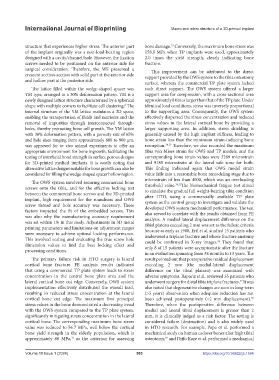Page 511 - IJB-10-1
P. 511
International Journal of Bioprinting Macro and micro structure of a 3D-printed implant
structure that experiences higher stress. The anterior part bone damage. Conversely, the maximum bone stress was
33
of the implant originally was a non-load-bearing region 158.8 MPa when TP implants were used, approximately
designed with a cavity/channel/hole. However, the fixation 2.0 times the yield strength, clearly indicating bone
screws needed to be positioned on the anterior side for fracture.
surgical consideration. Therefore, the WS presented a This improvement can be attributed to the direct
crescent section-section with solid part at the anterior side support provided by the OWS system to the tibia osteotomy
and hollow part at the posterior side.
surface, whereas the commercial TP plate system lacked
The lattice filled within the wedge-shaped spacer was such direct support. The OWS system offered a larger
YM type, arranged in a 30% deformation pattern. YM is a support area for compression, with a cross-sectional area
newly designed lattice structure characterized by a spherical approximately 8 times larger than that of the TP plate. Under
shape with multiple corners to facilitate cell clustering. The identical load conditions, stress was inversely proportional
6
internal structure of the YM lattice maintains a 3D space, to the supporting area. Consequently, the OWS system
enabling the transportation of fluids and nutrients and the effectively dispersed the stress concentration and reduced
removal of impurities through interconnected through- stress values in the lateral cortical bone by providing a
holes, thereby promoting bone cell growth. The YM lattice larger supporting area. In addition, stress shielding is
with 30% deformation pattern, with a porosity rate of 65% generally caused by the high implant stiffness, leading to
and hole sizes ranging from approximately 600 to 900 µm, bone strain less than the minimum strain-inducing bone
was approved for in vivo animal experiments to offer an resorption. 34,35 Therefore, we also recorded the maximum
appropriate environment for bone ingrowth, facilitating the tibia von Mises strain for OWS and TP models, and the
testing of interfacial bond strength in surface porous designs corresponding bone strain values were 3289 microstrain
for 3D-printed medical implants. It is worth noting that and 9185 microstrain at the lateral safe zone for both.
alternative lattice designs suitable for bone growth can also be This finding indicated again that OWS model strain
considered for filling the wedge-shaped spacer hollow region. value falls into a reasonable bone remodeling stage due to
microstrain of less than 4000, which was an overloading
The OWS system involved securing commercial bone 34,35
screws onto the tibia, and for the effective locking test threshold value. The biomechanical fatigue test aimed
to simulate the gradual full weight-bearing tibia condition
between the commercial bone screws and the 3D-printed after HTO, using a commercially available TP plate
implant, high requirement for the roundness and OWS system as the control group to investigate and validate the
screw thread and hole accuracy was necessary. These developed OWS system mechanical performance. The test
factors impacted the fit of the embedded screws. This also served to correlate with the results obtained from FE
was also why the manufacturing accuracy requirement analysis. A medial-lateral displacement difference on the
was set within 1% in this study. Adjustments in 3D metal tibial plateau exceeding 2 mm was set as the failure criteria
printing parameters and limitations on adjustment ranges because as early as 1988, Ertl et al. studied 15 patients who
were necessary to achieve optimal locking performance. underwent a triplane fracture and whose fracture anatomy
This involved scaling and evaluating the true screw hole could be confirmed in X-ray images. They found that
36
dimension values to find the best locking effect and only 8 of 15 patients were asymptomatic after the fracture
processing conditions.
in an evaluation spanning from 38 months to 13 years. The
The primary failure risk in HTO surgery is lateral result pointed out that postoperative residual displacement
cortical bone fracture. FE analysis results indicated exceeding 2 mm (the medial-lateral displacement
that using a commercial TP plate system leads to stress difference on the tibial plateau) was associated with
concentration in the central bone plate area and the adverse symptoms. Rapariz et al. reviewed 35 patients who
lateral cortical bone cut edge. Conversely, OWS system underwent surgery for distal tibia triplane fractures. It was
37
implementation effectively distributed the overall load, also noted that degenerative changes are seen in long-term
resulting in reduced stress concentration at the lateral (>5 years) observation when adequate reduction has not
cortical bone cut edge. The maximum first principal been achieved postoperatively (<2 mm displacement).
38
stress values in the bone demonstrated a decreasing trend Therefore, when the postoperative difference between
with the OWS system compared to the TP plate system, medial and lateral tibial displacement is greater than 2
significantly mitigating stress concentration in the lateral mm, it is clinically judged as a risk factor. The setting is
cortical bone. The corresponding maximum bone stress considered failure (destruction) and is also widely used
value was reduced to 56.7 MPa, well below the cortical in HTO research. For example, Pape et al. performed a
bone yield strength in the elderly population, which is mechanical study on human cadaver bones after high tibial
approximately 80 MPa, as the criterion for assessing osteotomy, and Diffo Kaze et al. performed a mechanical
32
38
Volume 10 Issue 1 (2024) 503 https://doi.org/10.36922/ijb.1584

